Charles E W Bean, Diaries, AWM38 3DRL 606/249/1 - 1917 - 1932 - Part 3
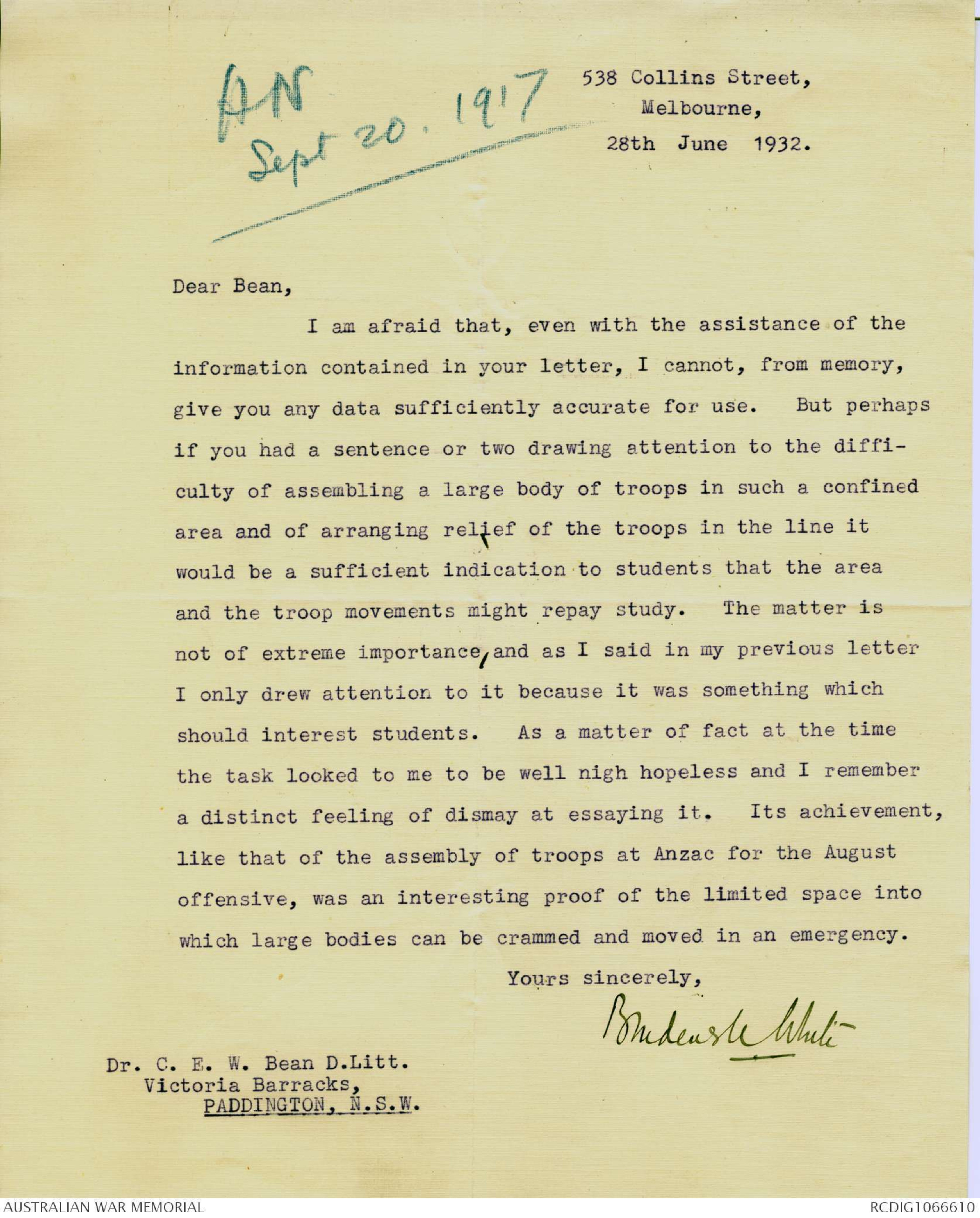
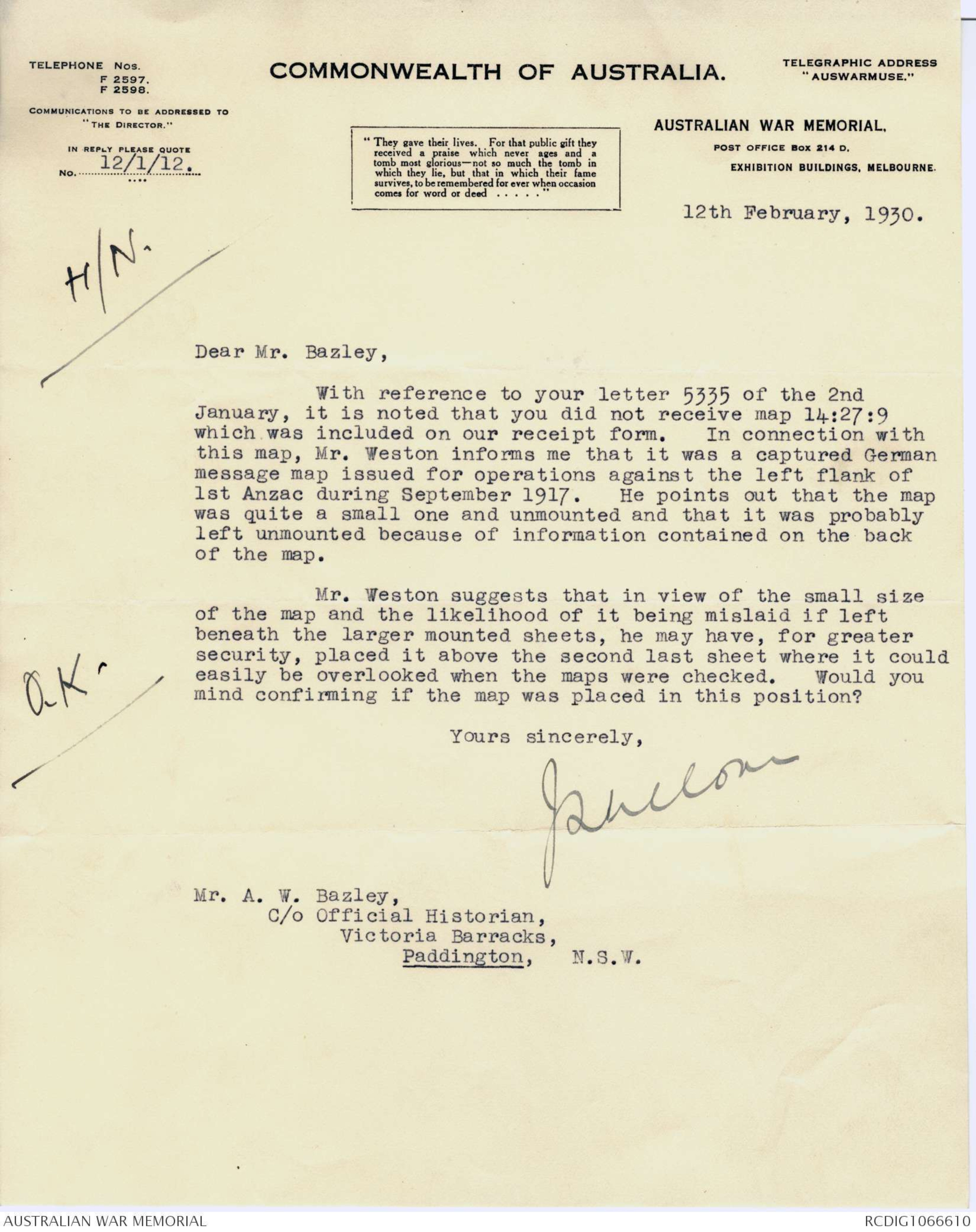
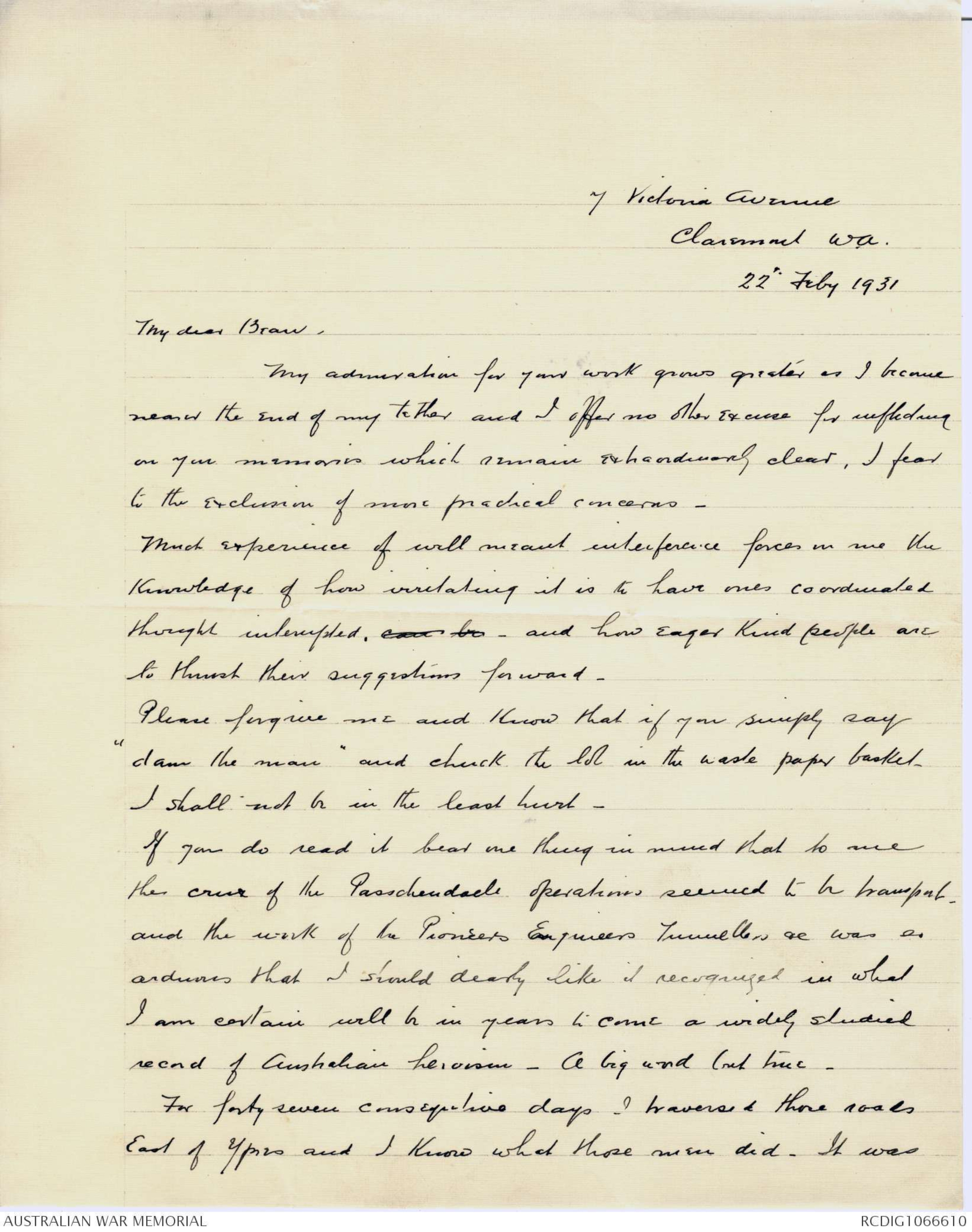
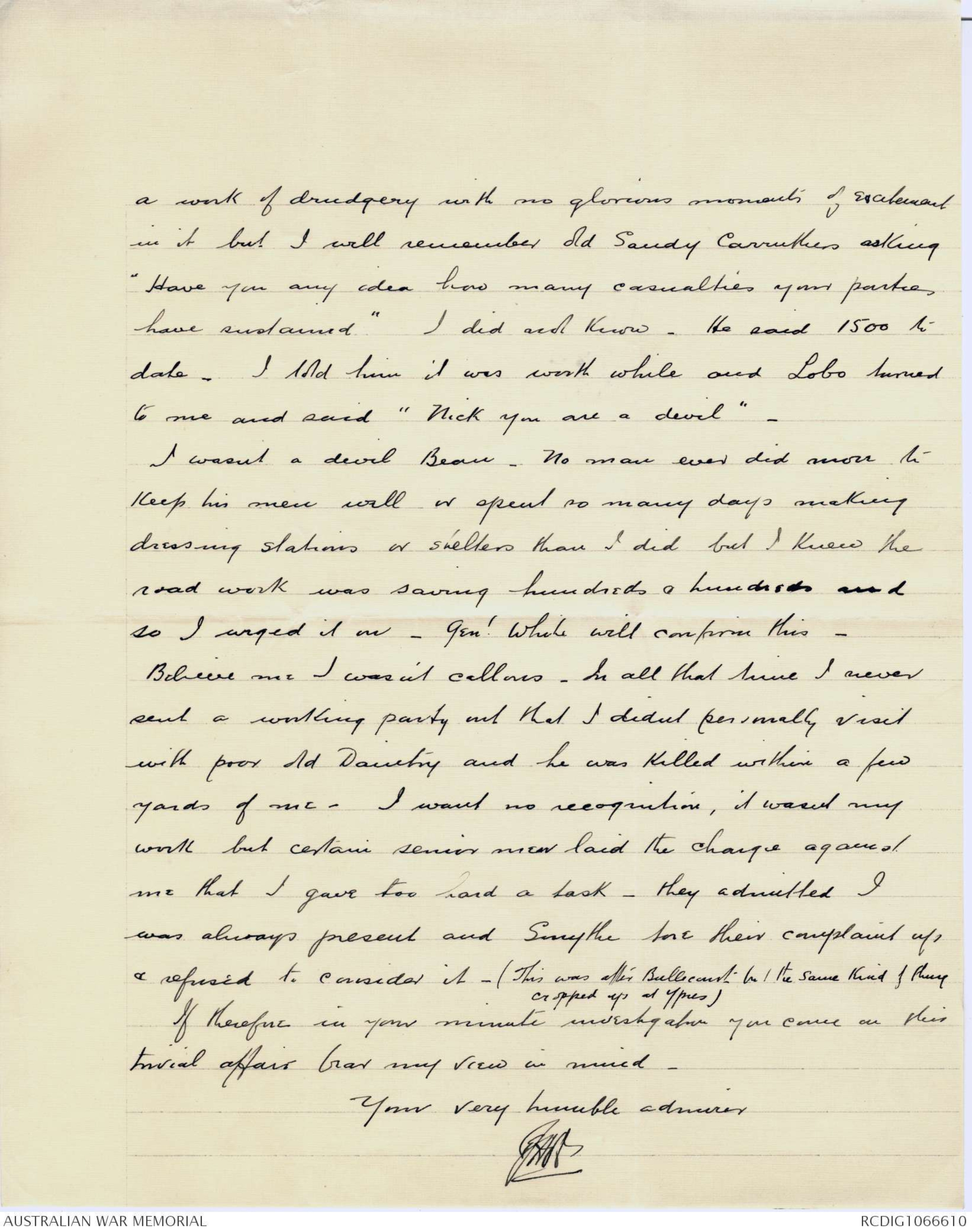
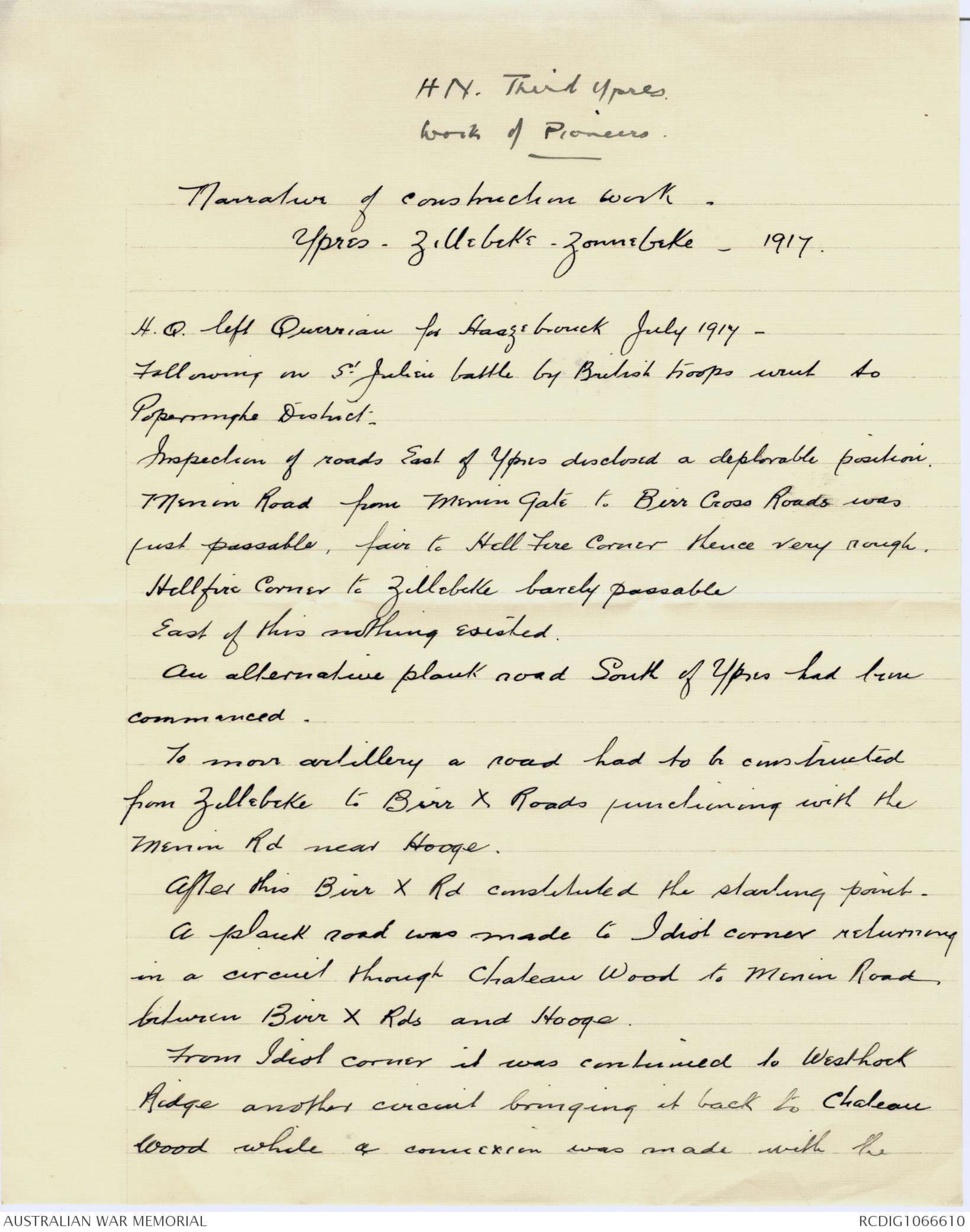

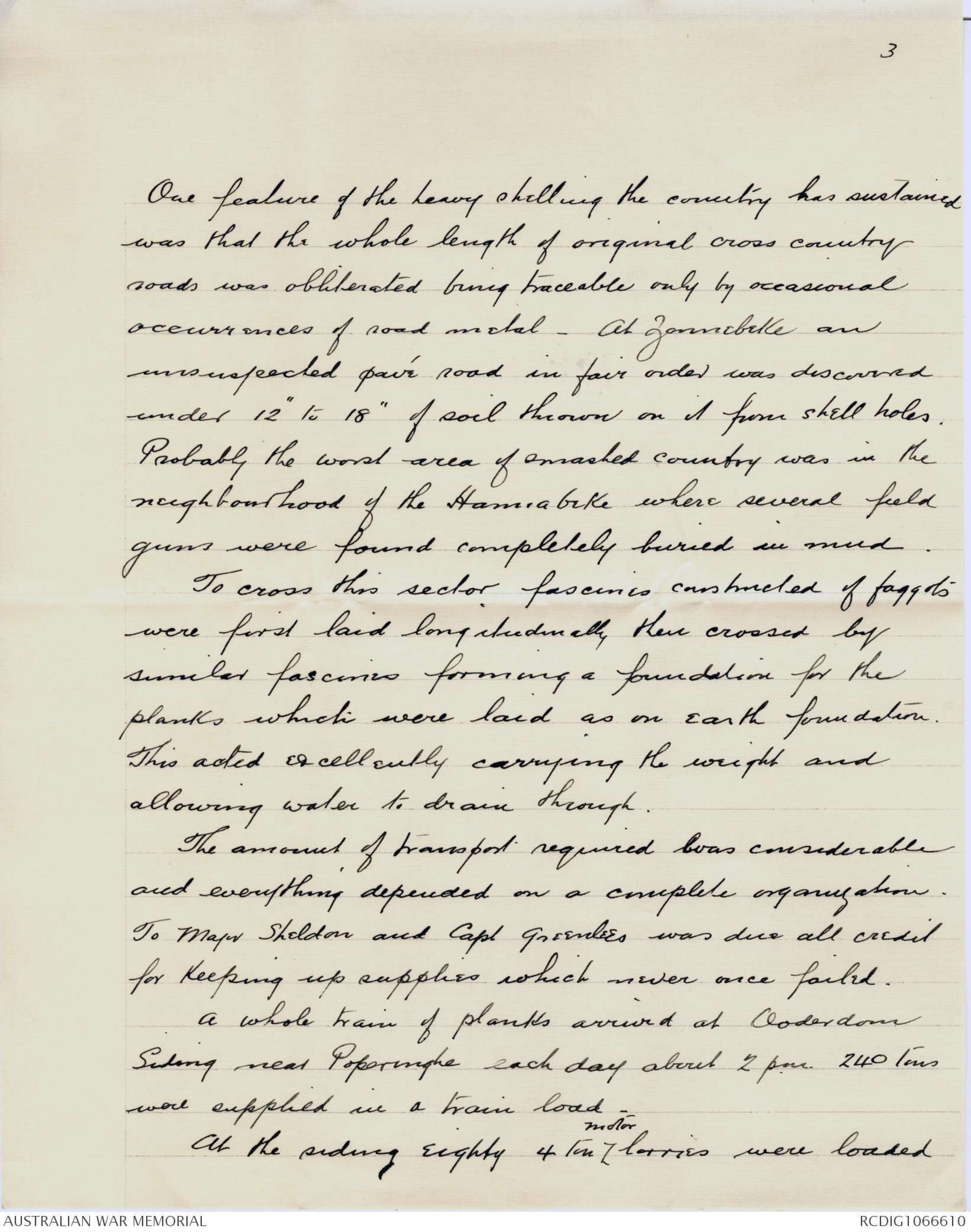
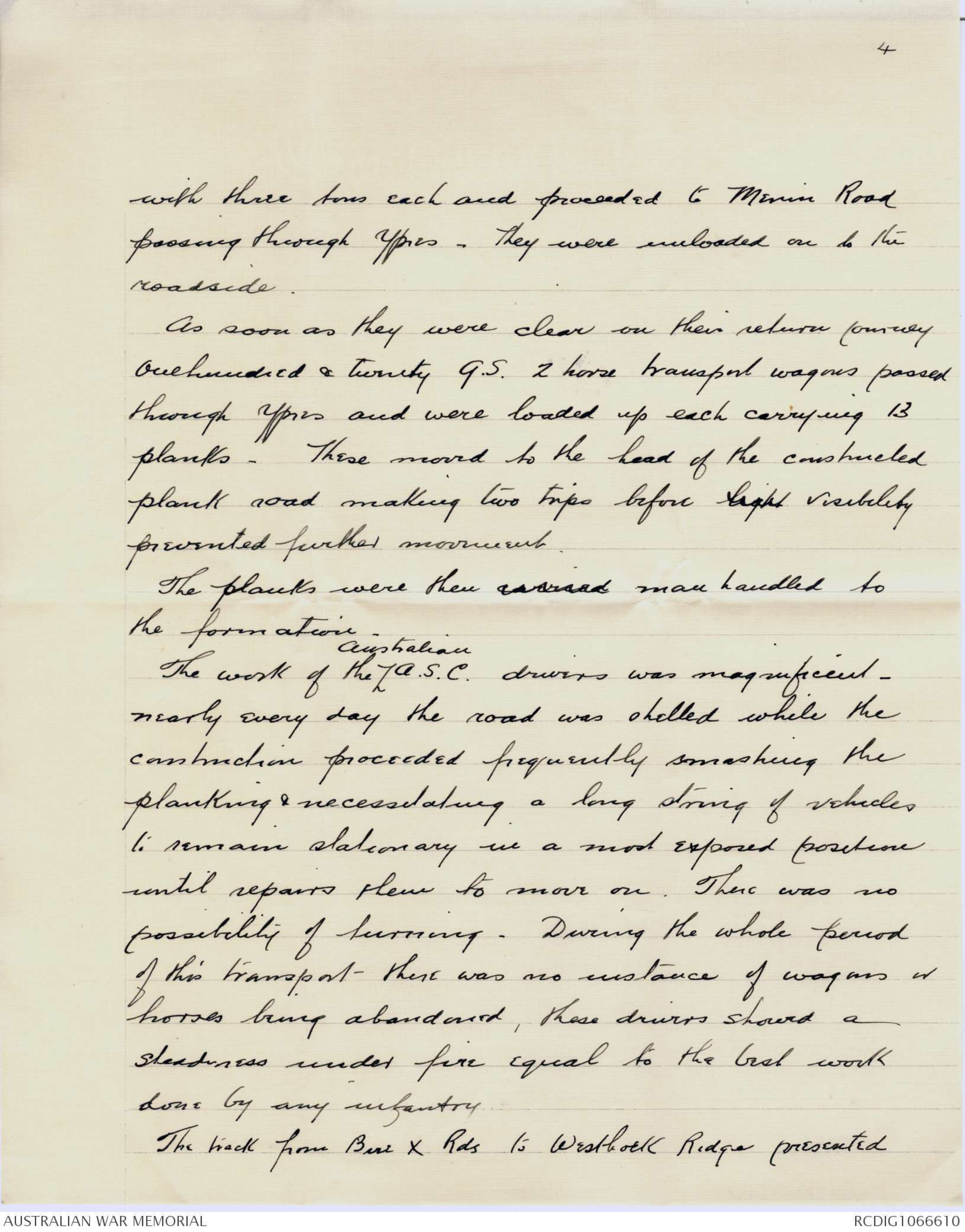
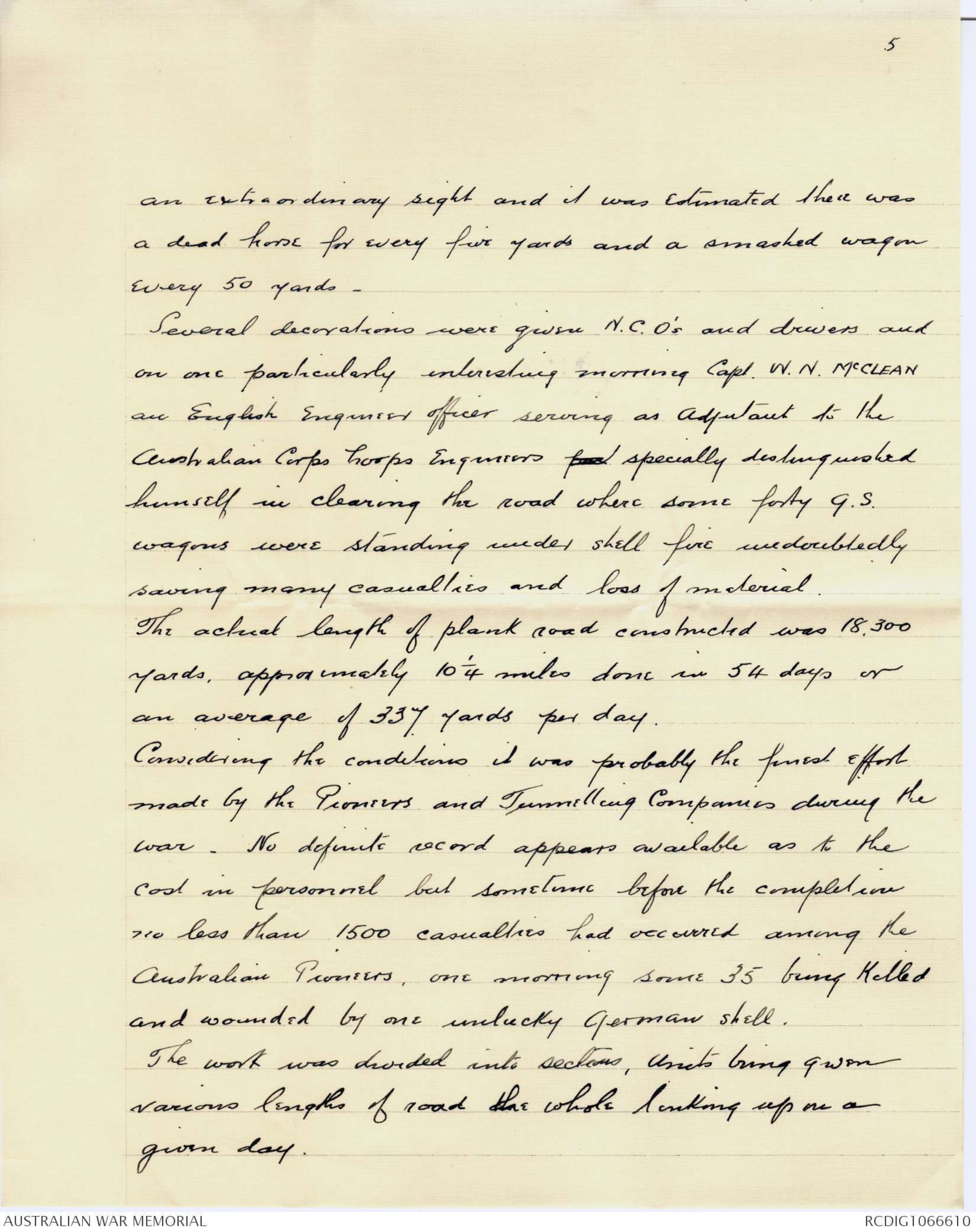
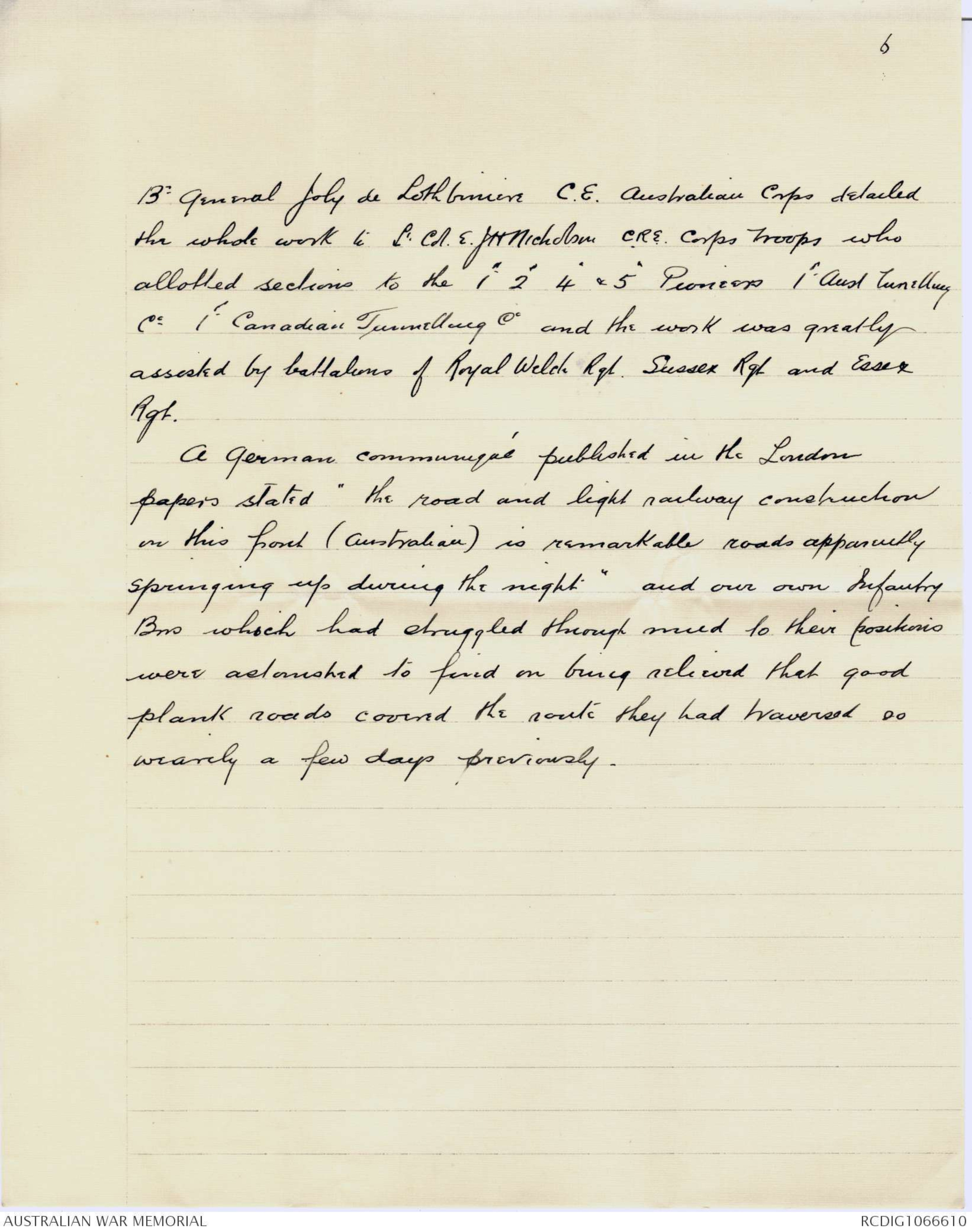
[*HN
Sept 20. 1917*]
538 Collins Street.
Melbourne,
28th June 1932.
Dear Bean,
I am afraid that, even with the assistance of the
information contained in your letter, I cannot, from memory,
give you any data sufficiently accurate for use. But perhaps
if you had a sentence or two drawing attention to the
difficulty of assembling a large body of troops in such a confined
area and of arranging relief of the troops in the line it
would be a sufficient indication to students that the area
and the troop movements might repay study. The matter is
not of extreme importance, and as I said in my previous letter
I only drew attention to it because it was something which
should interest students. As a matter of fact at the time
the task looked to me to be well nigh hopeless and I remember
a distinct feeling of dismay at essaying it. Its achievement,
like that of the assembly of troops at Anzac for the August
offensive, was an interesting proof of the limited space into
which large bodies can be crammed and moved in an emergency.
Yours sincerely,
Brudenell White
Dr. C. E. W. Bean D.Litt.
Victoria Barracks
PADDINGTON, N.S.W.
TELEPHONE Nos. COMMONWEALTH OF AUSTRALIA TELEGRAPHIC ADDRESS
F 2597. "AUSWARMUSE."
F 2598.
COMMUNICATIONS TO BE ADDRESSED TO
"THE DIRECTOR"
AUSTRALIAN WAR MEMORIAL
POST OFFICE BOX 214 D.
EXHIBITION BUILDINGS, MELBOURNE.
"They gave their lives. For that public gift they
received a praise which never ages and a
tomb most glorious—not so much the tomb in
which they lie, but that in which their fame
survives, to be remembered for ever when occasion
comes for word or deed . . . ."
12 February, 1930.
Dear Mr. Bazley,
With reference to your letter 5335 of the 2nd
January, it is noted that you did not receive map 14:27:9
which was included on our receipt form. In connection with
this map, Mr. Weston informs me that it was a captured German
message map issued for operations against the left flank of
1st Anzac during September 1917. He points out that the map
was quite a small one and unmounted and that it was probably
left unmounted because of information contained on the back
of the map.
Mr. Weston suggests that in view of the small size
of the map and the likelihood of it being mislaid if left
beneath the larger mounted sheets, he may have, for greater
security, placed it above the second last sheet where it could
easily be overlooked when the maps were checked. Would you
mind confirming if the map was placed in this position?
[*O.K.*]
Yours sincerely
J S Nelson
Mr. A.W. Bazley
C/O Official Historian,
Victoria Barracks
Paddington, N.S.W
7 Victoria Avenue
Claremont W.A.
22 Feby 1931
My dear Bean
My admiration for your work grows greater as I become
nearer the end of my tether and I offer no other excuse for reflecting
on your memories which remain extraordinarily clear, I fear
to the exclusion of more practical concerns -
Much experience of well meant interference forces on me the
knowledge of how irritating it is to have ones coordinated
thought interrupted. can be - and how eager kind people are
to thrust their suggestions forward -
Please forgive me and know that if you simply say
"damn the man" and chuck the lot in the waste paper basket
I shall not be in the least hurt -
If you do read it bear one thing in mind that to me
the crux of the Passchendaele operations seemed to be transport -
and the work of the Pioneers Engineers Tunnellers [[etc?]] was so
arduous that I should dearly like it recognized in what
I am certain will be in years to come a widely studied
record of Australian heroism - A big word but true -
For forty seven consequetive days I traversed those roads
East of Ypres and I know what those men did. It was
a work of drudgery with no glorious moments of excitement
in it but I will remember old Sandy Carruthers asking
"Have you any idea how many casualties your parties
have sustained" I did not know - He said 1500 to
date. I told him it was worth while and Lobo turned
to me and said "Nick you are a devil" -
I wasnt a devil Bean. No man ever did more to
keep his men well or spent so many days making
dressing stations or shelters than I did but I knew the
road work was saving hundreds & hundreds and
so I urged it on - Genl White will confirm this -
Believe me I wasn't callous - In all that time I never
sent a working party out that I didnt personally visit
with poor old Daintry and he was killed within a few
yards of me - I want no recognition, it wasnt my
worth but certain senior men laid the charge against
me that I gave too hard a task - they admitted I
was always present and Smythe tore their complaint up
& refused to consider it – (This was after Bullecourt but the same kind of thing cropped up at Ypres)
If therefore in your minute investigation you come on this
trivial affair bear my view in mind -
Your very humble admirer
[[?]]
HN. Third Ypres.
Work of Pioneers.
Narrative of construction work -
Ypres. Zillebeke. Zonnebeke - 1917
H.Q. left Querrian for Hazebrouck July 1917-
following on St Julien battle by British troops went to
Poperinghe District.
Inspection of roads East of Ypres disclosed a deplorable position
Menin Road from Menin Gate to Birr Cross Roads was
just passable, fair to Hell Fire Corner thence very rough.
Hellfire Corner to Zillebeke barely passable
East of this nothing existed.
An alternative plank road South of Ypres had been
commenced.
To move artillery a road had to be constructed
from Zillebeke to Birr X Roads junctioning with the
Menon Rd near Hooge.
After this Birr X Rd constituted the starting point.
A plank road was made to Idiot Corner returning
in a circuit through Chateau Wood to Menin Road
between Birr X Rds and Hooge.
From Idiot Corner it was continued to Westhoeck
Ridge another circuit bringing it back to Chateau
Wood while a connexion was made with the
2
main road at Frezenberg.
From Westhoek Ridge it was carried over the Hannebeek
to Zonnebeke thence across the railway towards
Paschendaele a return road being made by
rendering passable the main Ypres Zonnebeke Road
as far as Frezenberg -
These plank roads formed an unique passage
for artillery and infantry. They were mostly
constructed of elm but in one section oak planks
were used. The dimensions of the planks were
10 ft x 9 to 12 in x 2 to 2½ in -
The method adopted was to cut a drain in
either side of the construction filling in shell holes
and making a formation with the spoil from the
drains.
On this formation five planks were laid longitudinally
about 2 ft apart and on these a close decking of similar
planks was bolted the whole being secured by
an edging of 6" half round pinewood fastened
to the planks and forming a border enabling
transport to maintain the track.
They were one way roads. Passing sidings were
ineffective so circuits had to be made.
3
One feature of the heavy shelling the country has sustained
was that the whole length of original cross country
roads was obliterated being traceable only by occasional
occurrences of road metal. At Zonnebeke an
unsuspected pavė road in fair order was discovered
under 12" to 18" of soil thrown on it from shell holes.
Probably the worst area of smashed country was in the
neighbourhood of the Hannabeek where several field
guns were found completely buried in mud.
To cross this sector fascines constructed of faggots
were first laid longitudinally then crossed by
similar fascines forming a foundation for the
planks which were laid as on earth foundation.
This acted excellently carrying the weight and
allowing water to drain through.
The amount of transport required was considerable
and everything depended on a complete organization.
To Major Sheldon and Capt Graentes was due all credit
for keeping up supplies which never once failed.
A whole train of planks arrived at Ooderdom
Siding near Poperinghe each day about 2 pm. 240 tons
were supplied in a train load
At the siding eighty 4 ton ^motor lorries were loaded
4
with three tons each and proceeded to Menin Road
passing through Ypres. They were unloaded on to the
roadside.
As soon as they were clear on their return journey
one hundred & twenty G.S. 2 horse transport wagons passed
through Ypres and were loaded up each carrying 13
planks. These moved to the head of the constructed
plank road making two trips before light visibility
prevented further movement.
The planks were then man handled to
the formation.
The work of the ^Australian A.S.C. drivers was magnificent -
nearly every day the road was shelled while the
construction proceeded frequently smashing the
planking & necessitating a long string of vehicles
to remain stationary in a most exposed position
until repairs them to move on. There was no
possibility of turning. During the whole period
of this transport there was no instance of wagons or
horses bring abandoned, these drivers showed a
steadiness under fire equal to the best work
done by any infantry
The track from Birr X Rds to Westhoek Ridge presented
5
an extraordinary sight and it was estimated there was
a dead horse for every five yards and a smashed wagon
every 50 yards -
Several decorations were given N.C.Os and drivers and
on one particularly interesting morning Capt. W.N. McCLEAN
an English Engineer officer serving as Adjutant to the
Australian Corps Troops Engineers xxxx specially distinguished
himself in clearing the road where some forty G.S.
wagons were standing under shell fire undoubtedly
saving many casualties and loss of material.
The actual length of plank road constructed was 18,300
yards, approximately 10¼ miles done in 54 days or
an average of 337 yards per day.
Considering the conditions it was probably the finest effort
made by the Pioneers and Tunnelling Companies during the
war. No definite record appears available as to the
cost in personnel but sometime before the completion
no less than 1500 casualties had occurred among the
Australian Pioneers, one morning some 35 being killed
and wounded by one unlucky German shell.
The work was divided into sections, units being given
various lengths of road the whole linking up on a
given day.
6
Br. General Joly de Lothbiniere C.E. Australian Corps detailed
the whole work to Lt Col. E.J H Nicholson C.R.E. Corps troops who
allotted sections to the 1st 2nd 4th & 5th Pioneers Ist Aust Tunnelling
Co 1st Canadian Tunnelling Co and the work was greatly
assisted by battalions of Royal Welsh Rgt. Sussex Rgt and Essex
Rgt.
A German communiquė published in the London
papers stated "the road and light railway construction
on this front (Australian) is remarkable roads apparently
springing up during the night" and our own Infantry
Bns which had struggled through mud to their positions
were astonished to find on being relieved that good
plank roads covered the route they had traversed so
wearily a few days previously.
 Sandy Mudie
Sandy MudieThis transcription item is now locked to you for editing. To release the lock either Save your changes or Cancel.
This lock will be automatically released after 60 minutes of inactivity.